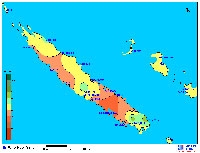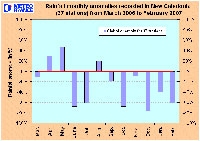Drought in New Caledonia Luc Maitrepierre, Meteo-France, Noumea, New Caledonia
Rainfall Assessment in New Caledonia from June 2006 to February 2007

Percentage of rainfall average.(Click for enlargement)

Rainfall monthly anomalies recorded in New Caledonia. (Click for enlargement)
A very low amount of rainfall was recorded in New Caledonia from June 2006 to February 2007, linked with the El Niño event that ended by February 2007. The average rainfall anomaly over this period and for 37 stations from Météo-France’s network was very signifi cant being only 52 percent of the average rainfall. In summary, only half of the usual rainfall amount was recorded for this period of 9 months.
The lack of rainfall affected all the country but it was even worse in the middle of the southern half of the Main Island where the rainfall anomalies were up to 37 percent of average in Boulouparis. The drought was felt more dramatically on the West Coast which is usually the driest part of the archipelago. In this region, the recorded rainfall amounts are very low: 247 mm in Boulouparis, 255 mm in La Tontouta Airport, 311 mm in Nouméa.
Moreover this El Niño event deeply affected the rainy season. January and February are usually two of the wettest months of the year, but this year the rainfall defi cit was very high particularly in February being below average by 61 percent For example, there was only 53 mm of rainfall recorded in La Tontouta in January and February compared to the average amount of 257 mm. The fear is now that the wet season will not bring enough water to recover from this very dry period.
The drought really started in June and July 2006 with anomalies below average of 68 and 62 percent respectively. For the June 2006 to February period, August was the only month with above average rainfall (+20%). Five months out of the 9 month period recorded very low rainfall anomalies of over -60% (June, July, October, December and February) with a maximum of -78% in December.
The impacts were mostly observed on livestock farming. Alerted by a press conference in early September and Météo-France monthly seasonal forecast, the local government services were very quick to react. They provide substantial financial aid to farmers to help them buy hay or other cattle food to save the livestock. The Civil Security reinforced their fire warning and fi ghting system with a great success as the bush fires have been quickly contained.
Finally, this "moderate" El Niño event had a very important impact on rainfall in New Caledonia. The effects of this drought have been efficiently managed by the local authorities who were correctly informed of the situation and forecasted evolution by Météo-France.
